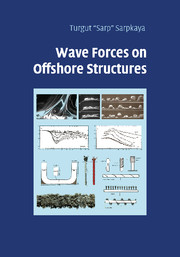1 - Introduction
Published online by Cambridge University Press: 05 July 2014
Summary
It is appropriate to begin this introduction with a thoughtful reminder by Sir Geoffrey Ingram Taylor (1974): “Though the fundamental laws of the mechanics of the simplest fluids, which possess Newtonian viscosity, are known and understood, to apply them to give a complete description of any industrially significant process is often far beyond our power.” This is particularly true for oil-hungry mankind’s desire for hydrocarbons, with pollution as a bonus. The principal difficulties stem from the problems associated with the determination of the state of the sea, the three-dimensional and random nature of the ocean–structure interaction, quantification of the forces exerted on structures, and the lack of a fluid-mechanically satisfying closure model for turbulence. The past hundred years have shown that “almost-randomness” is the law of the physics of turbulence. One can quantify the consequences of turbulence and probe into its behavior for a given event only through approximate models and physical and numerical experiments (provided that the wideband of relevant scales is fully resolved). Even if the direct numerical simulations (DNSs) at Reynolds numbers as high as 107 were possible in the centuries to come, the large parameter space in any application precludes a purely numerical solution.
The past four decades have seen an explosion of interest in the broad subject of ocean hydrodynamics. This interest led to an improved and more realistic understanding of the physical characteristics of some time-dependent flows about bluff bodies and their mathematical formulation and experimental exploration. On the one hand, attention has been focused on controlled laboratory experiments, which allow for the understanding of the separate effects of the governing and influencing parameters, and, on the other hand, on mathematical and numerical methods, which allow for the nearly exact solution of some wave-loading situations (large bodies, whose volumes are as large as 10 times that of the great pyramid of Khufu). For many practically significant fluid–structure interactions involving flow separation, vortex motion, turbulence, dynamic response, and structural and fluid-dynamical damping, however, direct observations and measurements are continuing to provide the needed information, whereas theory has not yet played an important role.
- Type
- Chapter
- Information
- Wave Forces on Offshore Structures , pp. 1 - 6Publisher: Cambridge University PressPrint publication year: 2010

